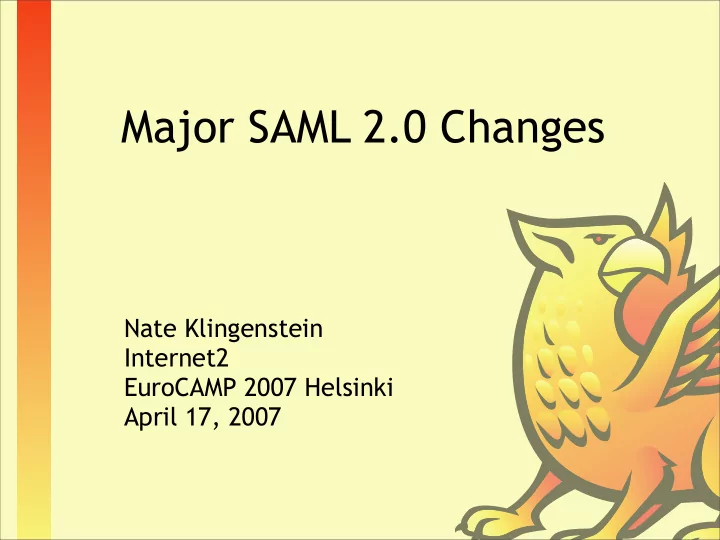

Major SAML 2.0 Changes Nate Klingenstein Internet2 EuroCAMP 2007 Helsinki April 17, 2007
Tokens, Protocols, Bindings, and Profiles • Tokens are requests and assertions • Protocols bindings are communication mechanisms for transfer of requests and assertions on transport protocols • e.g. SAML SOAP Binding • Profiles are detailed instructions for use of profiles to accomplish a task • e.g. Web Browser SSO • SAML tokens may be used outside SAML protocols 2
Major New SAML 2.0 Features • AuthnRequest • Encryption • Single Logout Profile • Detailed AuthnContext • Third-Party Requester • Enhanced Client or Proxy (ECP) Profile • ... and more 3
SAML 2.0 AuthnRequest • It exists • SAML 1.1 didn’t have an authentication request • Shibboleth 1.x invented one: • https://www.idp.org/SSO?providerId=X&target=Y&SHIRE=Z • Lots of things may be asked for • Especially authentication contexts • How do you answer a request for ABC method “or better”? • Unfortunately, not attributes 4
SAML 2.0 AuthnRequest • IsPassive • Mandates the IdP not interact with the user at all in handling this request • Allows for transparent authentication checks • ForceAuthn • Requires that the IdP reauthenticate the user even if a valid authentication session is still in place • Ensure authentication is current • Authentication “upgrades” 5
Third-Party Requester • SAML 2.0 Requests may be signed • Third-party is used when the requester isn’t the intended recipient • SSO may be triggered by portals, content aggregators, intelligent clients, etc. • Possible in Shibboleth 1.x • What is trust based upon? • Issuer, Requester, Presenter, and Recipient • Is the requester most important? The recipient? 6
Confidentiality & Encryption • XML-Signature signing of assertions, requests, responses • “Sign the Blob” SimpleSign signs the entire SAML message as an octet string • Encryption of: • Assertions • Attributes • NameID’s • TLS/SSL as well 7
Single Logout • Caveat Emptor: the world has lots of sessions • IdP , SPs, authentication, individual apps • How many can you get? • Introduces a significant amount of state at both the IdP and SP • Logout from browser-based applications may be performed two ways: front channel or back channel 8
Single Logout • Front channel: the browser delivers the logout message • Cycle the browser through all applications at all SP’s? • Be careful: browsers are fragile • Allows the apps to destroy any cookies they need to • Back channel: a SOAP or other call is made directly from the provider to the application • More reliable, but apps have less power 9
Discovery Service • Allows for more intelligent IdP selection and discovery • The old WAYF flow: SP -> WAYF -> IdP -> SP • This breaks because of the new complexity in authentication request • Signing • Multiple protocols including SAML 2 • The new Discovery Service (DS) flow: SP -> DS -> SP -> IdP -> SP 10
Discovery Service • May be centrally operated like today’s WAYF • Also could be located at the SP • Many interesting parameters may be passed • Can fit with WS-Federation 1.1’s “Home Realm Discovery” • Additional endpoint required in metadata to avoid phishing • http://www.oasis-open.org/committees/download.php/22041 11
Authentication Context • Interesting Venn diagram with levels of assurance • Describes only how a specific authentication event was performed • In painful detail • Many different things factor into LoA • Strength of authentication (e.g. AuthnContext) • Strength of credential issuance • In a federated world, strength of transactions & flows 12
Authentication Context • May be requested & asserted • Very difficult to use to establish a minimum level because methods aren’t ranked • And there’s so many to choose from • Shibboleth will allow for requested and supported contexts • If there’s a match between requested and supported, or asserted and accepted, the transaction’s good 13
Attribute Profiles & Naming • These exist now too • Basic • LDAP • UUID • XACML • Name, NameFormat, FriendlyName, Value • NameFormat isn’t always URI, and often is very creatively used 14
Name Identifiers • Subject of assertions • eduPersonTargetedId -> persistent • handle -> transient • Many others: Kerberos, X.509, emailAddress, etc. • May be encrypted • Separate profile to manage changes • But many of these are what we’ve classically considered attributes... 15
Relationship to Other Standards • WS-Security: SAML Token Profile OASIS Standard • Places a SAML token in a SOAP header • WS-Trust • The ultimate “another layer of abstraction” approach • ID-WSF 2.0 • Supplements SAML in a number of important ways • Endpoint references • SSOS profile now being ported to SAML 16
Relationship to Other Standards • OpenID • In many ways, peer-to-peer to SAML’s enterprise • Fundamental differences aren’t large and convergence discussions are ongoing • Higgins • Intended to be an API that abstracts identity management functionality entirely • Authentication OSID and OKI haven’t seen much success 17
Relationship to Other Standards • Cardspace (InfoCard) • Provides the ultimate: a client on the desktop • Excellent identity selector functionality • Phishing protection (more important for OpenID than SAML) • Lots of other standards out there • ADFS, WS-Federation, WS-Policy, etc. 18
Interoperability • With flexibility comes responsibility • SAML 2.0 profiles reasonably well-defined, but still much room for interpretation • Cooperation and understanding by deployers will be important • Shibboleth 2.0 is as flexible and agnostic as possible 19
Recommend
More recommend